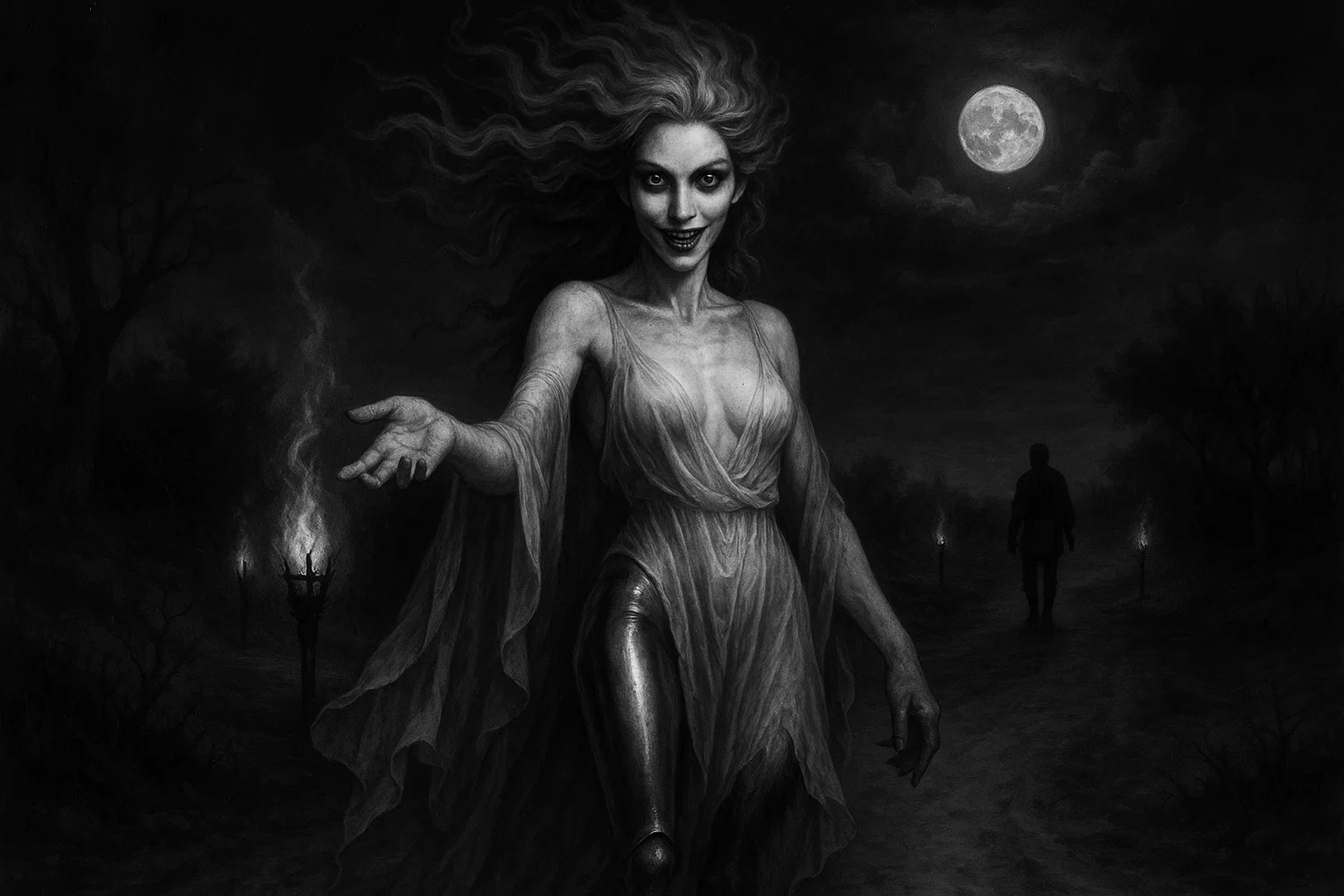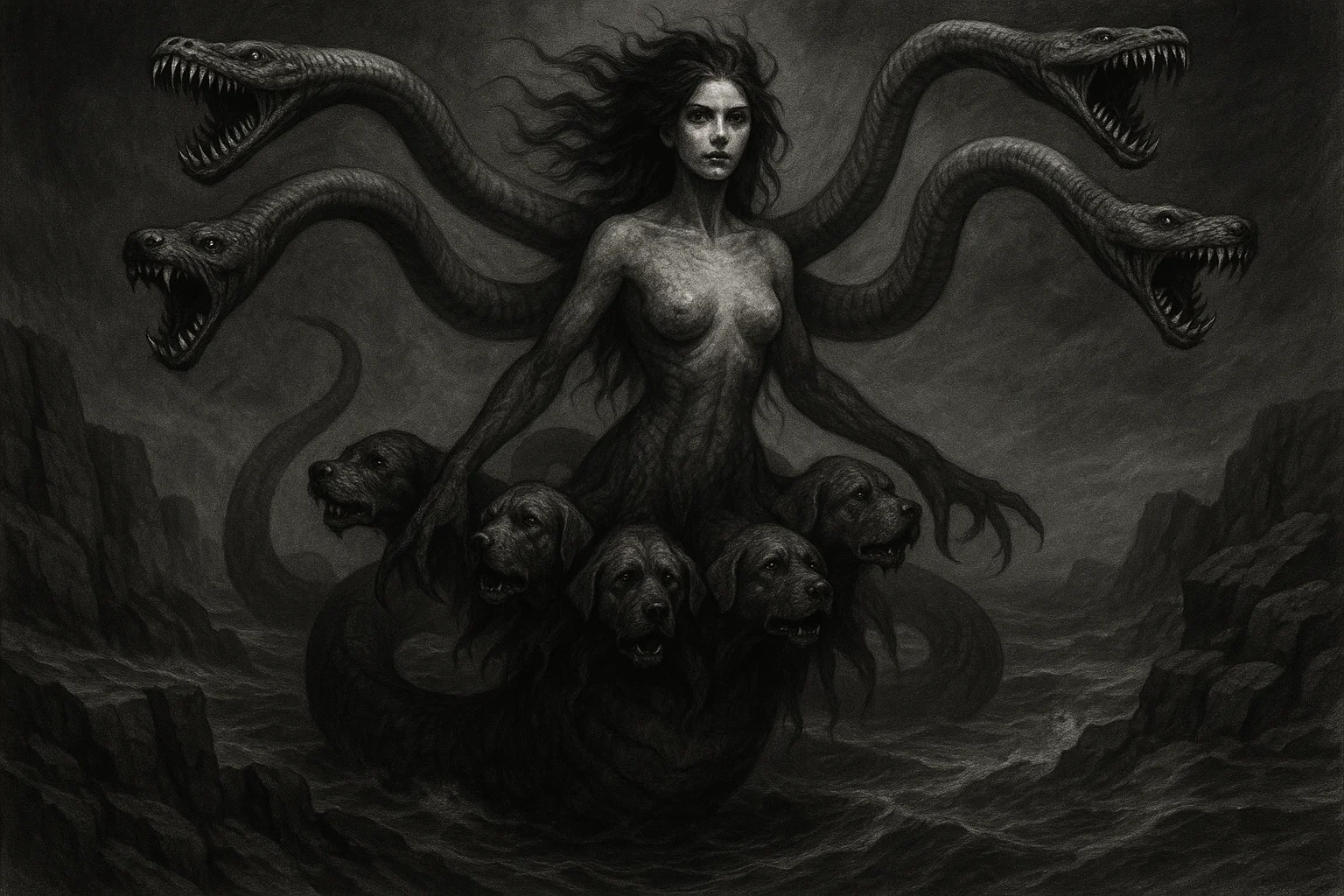Empusa is a chilling specter of desire and doom. Commanded by the enigmatic goddess Hecate, this demonic entity lured unwary travelers and youthful wanderers with visions of ethereal beauty, only to reveal her monstrous hunger in the dead of night.
As a harbinger of Hecate’s nocturnal realm, Empusa embodied the perils of unchecked passion, her tales woven into the fabric of Greek folklore as warnings against the seductive whispers of the dark.
Long before the rise of later demonologies, Empusa prowled the myths of classical antiquity, her form a twisted mirror to human vulnerabilities. From comedic frights in Aristophanes’ plays to the philosophical confrontations in Philostratus’ accounts, she haunted the Greek imagination as a phantom of transformation and terror.
Summary
Key Information
| Category | Details |
|---|---|
| Name | Empusa, Empousa, Empousai (plural), Onokole (“Donkey-Legged”), Onoskelis (“Donkey-Footed”), Oinopole (“Wine-Seller” or “Ass-Legged”) |
| Title | The One-Footed Phantom, Hecate’s Emissary, Shape-Shifting Specter, Bogey of the Night |
| Gender | Female |
| Role | Seductive demon who lures and devours young men; frightens travelers and children; servant of Hecate in guarding crossroads and roadsides |
| Hierarchy | Subordinate to Hecate in the chthonic (underworld) hierarchy; not ranked in infernal Christian demonologies but akin to mid-tier daimones in Greek lore |
| Servitors | None explicitly named; sometimes grouped with Lamiai and Mormolykeiai as a collective of similar specters under Hecate |
| Superior Demon | Hecate (goddess of witchcraft, crossroads, and the night; occasionally identified as Empusa herself) |
| Powers | Shape-shifting (into beautiful women, animals like bulls, mules, dogs, or oxen); blood-drinking and flesh-eating; illusion-casting to seduce victims; vanishing into thin air |
| Appearance | Upper body of a beautiful woman with flaming hair; lower body with one leg of bronze/copper/brass and one donkey’s or ass’s leg; sometimes multiple mismatched feet in folklore variants; ghostly or phantom-like pallor |
| Etymology | From Greek empousa, folk etymology meaning “one-footed” (en-pous: one + foot); possibly pre-Greek origin linked to “forcing in” or emerging from dark places |
| Associated Figures | Hecate (mistress), Lamia (child-devouring counterpart), Mormo (bogey spirit), Dionysus (frightened victim in myths), Apollonius of Tyana (exorcist who repels her) |
| Weaknesses | Repelled by abusive insults, mockery, and laughter; vulnerable to divine intervention (e.g., Heracles’ name); exposure of true form causes flight with shrieks |
| Opposing Angel/Saint | None in Greek lore; in later Christian syncretism, akin to saints warding off demons like St. Michael; Apollonius of Tyana serves as a philosophical “opposer” |
| Equipment/Tools | None; relies on natural illusions and shape-shifting; in rituals, associated with Hecate’s torches or crossroads offerings, though not wielded by Empusa |
| Pantheon | Greek (chthonic/underworld division); later influences in Roman and Byzantine folklore |
Etymology
The name Empusa derives from ancient Greek roots that evoke her eerie, lopsided mobility, a trait central to her terrifying presence.
Scholars interpret it through a folk etymology as “one-footed” or “she who moves on one leg,” combining en- (one) and pous (foot), reflecting her signature mismatched limbs—one of gleaming bronze and the other a cloven donkey’s hoof. This etymology underscores her role as a liminal being, forever unbalanced between the seductive human form and the grotesque underworld phantom.
Deeper linguistic analysis suggests that the term may predate Greek, possibly originating from a non-Indo-European substrate language spoken by the early inhabitants of the Aegean region. Some philologists link it to empusae, implying “forcers-in” or entities that thrust themselves into the mortal realm from hidden voids, aligning with her sudden apparitions at crossroads.
In Byzantine texts, such as the Suda lexicon, Empusa is explicitly linked to heni podizein (moving on one foot), highlighting her hobbling gait as a marker of her otherworldly nature.
This nomenclature also connects to broader Indo-European motifs of hybrid monsters, where asymmetry symbolizes chaos and disorder. By late antiquity, the plural empousai denoted a class of specters, blurring Empusa from singular demon to collective haunt.
Such etymological layers reveal how her name encapsulated Greek anxieties about the unstable boundaries of reality, desire, and death, making Empusa a linguistic embodiment of nocturnal dread.
You May Also Like: Dajjal, the One-Eyed Antichrist Who Deceives the World
What Does Empusa Look Like?
Empusa‘s visage is a masterful illusion of allure masking visceral horror, designed to ensnare the senses before unleashing terror.
In her most infamous guise, she manifests as a stunning young woman with porcelain skin, cascading locks of flame-like hair that flicker like distant hearth fires, and eyes that gleam with an unnatural, hypnotic allure. This form draws victims close, her lithe figure clad in diaphanous silks that whisper promises of forbidden ecstasy.
Yet, beneath this veneer lies her true, monstrous anatomy: a torso that abruptly twists into impossibility, supported by legs of stark contrast—one forged from cold, unyielding bronze that clangs against the earth like a blacksmith’s hammer, the other a shaggy, cloven hoof of a donkey, reeking of barnyard filth and underworld decay.
In some accounts, her frame elongates into a spectral thinness, with additional phantom limbs—ox, goat, or even human—sprouting in folklore variants, evoking a spider-like scuttle across moonlit paths.
Her presence carries an acrid scent of scorched metal and damp earth, and when enraged or exposed, her features contort: skin pales to ghostly translucence, revealing veins like rivers of shadow, while her maw widens to jagged fangs suited for rending flesh.
This duality—beauty as bait, monstrosity as trap—defines Empusa‘s physical essence, a visual parable of temptation’s treacherous core.
Historical and Mythological Background
Empusa‘s legends thrive in the liminal spaces of Greek storytelling, where comedy and philosophy intersect to portray her as both farce and fright.
Rooted in folk beliefs predating written records, she served as Hecate’s enforcer, patrolling desolate roads to punish the wayward or simply to sate her insatiable appetites. These tales, preserved in classical drama and biography, highlight her as a daimone of disruption, her exploits warning against solitude under the stars.
The Fright of Dionysus in the Underworld
In Aristophanes’ comedic masterpiece The Frogs (405 BCE), Empusa crashes into the divine journey of Dionysus and his slave Xanthias as they descend to Hades.
Amid the marshy gloom near Lake Acheron, Xanthias spots the specter first, her form shifting wildly from a bellowing bull to a stubborn mule, then a ravishing maiden whose gaze promises delights untold. Panic ensues as she morphs into a snarling dog, her bronze leg glinting ominously beside a fresh cow dung, a detail that sends Dionysus into quaking terror.
The god, ever the coward in Aristophanes’ satire, invokes Heracles’ name repeatedly, while Xanthias—perhaps inventing the encounter to prank his master—hurls insults that make the phantom shriek and dissolve into vapor. This episode, blending slapstick with genuine folk horror, underscores Empusa‘s role as a roadside terror, her illusions crumbling under ridicule.
You May Also Like: The Demon Div: The Terrifying Horned Demon of Chaos
Apollonius of Tyana’s Exorcism on the Road to India
Philostratus’ Life of Apollonius of Tyana (3rd century CE) elevates Empusa to a philosophical adversary, pitting the sage against her in a tale that pits intellect against instinct.
En route from Persia to India, Apollonius and his followers camp under a full moon on Mount Caucasus, where the demon materializes as a voluptuous woman, her bronze leg concealed in shadows as she weaves spells of seduction. The air thickens with her illusions, but the philosopher pierces the veil, recognizing her as a phasma—a deceptive ghost fattening travelers for slaughter.
With calm authority, Apollonius unleashes a barrage of mockery, branding her a “shameless slut” and “cowardly ass-haunch,” goading his companions to join the verbal assault. Empusa recoils, her form flickering like a dying flame, before fleeing with ear-piercing wails that echo through the peaks.
This confrontation, drawn from oral traditions, portrays Empusa not as invincible but as brittle, her power waning against unyielding scorn—a nod to Pythagorean ideals of rational mastery over base fears.
The Corinthian Lamia’s Fatal Embrace
Though often conflated with Empusa in late sources, the tale of the Corinthian Lamia in Philostratus’ work illustrates their shared predatory archetype. Haunting the bustling city of Corinth, this Empusa-like specter poses as a wealthy bride to ensnare the philosopher Menippus, showering him with illusory riches and passion.
On their wedding night, as he drifts toward consummation, Apollonius intervenes, shattering the glamour to reveal her serpentine tail and vampiric hunger—she had been “fattening” him for weeks, craving the “freshness and purity” of youthful blood.
The demon confesses her endless cycle of lures and feasts, devouring scores of suitors before dissolving in shame under the sage’s gaze. This narrative, blending romance with revulsion, expands Empusa‘s myth into an urban legend, warning of deception in the pursuit of prosperity. It highlights her evolution from rural phantom to cosmopolitan threat, mirroring Greece’s shifting societal perils from wilderness to polis.
These stories, sparse yet vivid, cement Empusa‘s place in Greek lore as a multifaceted menace—comic relief in theater, moral exemplar in biography. Absent from epic poetry, such as that of Homer or Hesiod, her prominence in drama and prose suggests a folkloric core, amplified by Hecate’s cult, which enforced taboos on nocturnal wandering and unchecked lust.
You May Also Like: What Is a Marid? The Demon That Defies Heaven
Historical Mentions
| Text/Grimoire | Year | Description | Excerpt |
|---|---|---|---|
| Aristophanes, The Frogs | 405 BCE | Empusa appears as a shape-shifting phantom terrifying Dionysus and Xanthias en route to Hades, embodying comedic horror with her mismatched legs and rapid transformations. | “Xanthias: Hallo! I hear a noise. Dionysos: Where? what? Xanthias: Behind us, there. Dionysos: Get you behind. Xanthias: No, it’s in front. Dionysos: Get you in front directly. Xanthias: And now I see the most ferocious monster. Dionysos: O, what’s it like? Xanthias: Like everything by turns. Now it’s a bull: now it’s a mule: and now the loveliest girl. Dionysos: O, where? I’ll go and meet her. Xanthias: It’s ceased to be a girl: it’s a dog now. Dionysos: It is Empousa! Xanthias: Well, its face is all ablaze with fire. Dionysos: Has it a copper leg? Xanthias: A copper leg? yes, one; and one of cow dung.” |
| Aristophanes, Ecclesiazusae | 392 BCE | A young man rejects an elderly woman’s advances by likening her to an Empusa, highlighting the demon’s grotesque, blemished true form beneath illusions of beauty. | “[A young man disparages an old woman who had tried to seduce him:] It is an Empousa with a body covered with blemishes and blotches.” |
| Philostratus, Life of Apollonius of Tyana (Book 2, Chapter 4) | 3rd century CE | Apollonius encounters an Empusa on Mount Caucasus, repelling her illusions and shape-shifting with insults, portraying her as a vulnerable phantom. | “They were travelling by bright moonlight [across Mount Kaukasos], when the figure of an Empousa appeared to them, that changed from one form to another, until finally it vanished into nothing. And Apollonios realised what it was, and himself heaped abuse on the Empousa and instructed his party to do the same, saying that this was the right remedy for such a visitation.” |
| Philostratus, Life of Apollonius of Tyana (Book 4, Chapter 25) | 3rd century CE | An Empusa seduces a philosophy student in Corinth, confessing her vampiric intent to fatten and devour him, revealed by Apollonius during a mock wedding. | “This empousa confessed it was fattening up the student she targeted to feed on him, and that she especially craved young men for the freshness and purity of their blood.” |
| Suidas (Byzantine Lexicon), s.v. Empousa | 10th century CE | Defines Empusa as a demonic ghost sent by Hecate, emphasizing her shape-shifting and one-legged movement as a hallmark of her spectral nature. | “Empousa (Empusa). A demonic ghost (phantasma daimonios) sent by Hekate and appearing to the ill-fated. [Something] which seems to change into many forms. Aristophanes in Frogs [indicates this]. [It is called] Empousa from the fact that it moves on one leg (heni podizein), i.e. that its other leg is bronze.” |
| Bernhard Schmidt, Griechische Reise (Folklore Collection) | 1858 CE | Records modern Greek oral lore from Arachova, describing an Empusa-like figure as a slender woman with multiple mismatched feet, syncretized with Lamia traits. | “An extremely slender woman with multiple feet, one of bronze, one a donkey’s foot, one an ox’s, one a goat’s, and one human… with a lamia-like body and gait.” |
You May Also Like:
Empusa’s Powers and Abilities
Empusa wields powers rooted in deception and primal hunger, distinguishing her from generic spirits through her intimate, tactile corruptions.
Unlike broad tempters who whisper vices from afar, she embodies corporeal seduction, using illusions to infiltrate dreams and desires, drawing victims into physical union before the fatal feast. Her abilities are corrupted by exploiting human frailty—lust as the gateway to annihilation—transforming fleeting pleasure into an eternal void.
At her core is shape-shifting, a fluid metamorphosis that blurs the line between beast and beauty, allowing her to infiltrate isolated lives. This power tempts by mirroring the victim’s deepest yearnings: a lost love’s face, a courtesan’s grace, or an animal’s wild fury to scatter the wary.
Once ensnared, her vampiric feeding drains not just blood but vitality, symbolizing the soul’s erosion through indulgence. In Greek lore, this act corrupts the community too, as devoured youths leave families bereft, perpetuating cycles of grief and superstition.
Her phantom nature enables intangibility, allowing her to slip through walls or dissolve under scrutiny, which fosters paranoia—every shadow a potential lover turned devourer. Empusa‘s shrieks, elicited by exposure, serve as psychological weapons, amplifying fear to isolate prey further.
| Power/Ability | Description | Source | How It Tempts/Corrupts Humans |
|---|---|---|---|
| Shape-Shifting | Rapid transformation into animals (bull, mule, dog) or beautiful women to approach and disarm victims. | Aristophanes, The Frogs (405 BCE) | Lures with idealized forms, corrupting through false intimacy and betrayal of trust, leading to spiritual isolation. |
| Illusion-Casting | Projects glamorous facades of wealth, beauty, or affection to fatten and seduce before revealing truth. | Philostratus, Life of Apollonius (4.25, 3rd century CE) | Tempts with material or romantic fantasies, eroding moral judgment and fostering addiction to deception. |
| Vampiric Feeding | Sucks blood and devours flesh from ensnared young men, craving their “freshness and purity.” | Philostratus, Life of Apollonius (4.25, 3rd century CE) | Corrupts via post-coital horror, symbolizing lust’s deadly toll and polluting the victim’s legacy through untimely death. |
| Phantom Dissolution | Vanishes into vapor or hides when mocked, but reemerges stronger in isolation. | Suidas, s.v. Empousa (10th century CE) | Instills chronic fear of the night, tempting avoidance of social bonds and deepening personal paranoia. |
| Shriek-Inducing Flight | Emits high-pitched wails when repelled, echoing to unnerve pursuers. | Philostratus, Life of Apollonius (2.4, 3rd century CE) | Corrupts communal courage, turning group defiance into fragmented terror and eroding collective resilience. |
How to Counter Empusa’s Powers
Countering Empusa demands wit over weaponry, exploiting her fragility to ridicule and revelation. In ancient accounts, the most reliable ward is verbal abuse—sharp-tongued mockery that strips her illusions bare.
Travelers invoked heroes like Heracles or hurled epithets like “cowardly ass” to provoke her flight, her shrieks a testament to vulnerability against human scorn. This method, rooted in Pythagorean philosophy, highlights laughter’s ability to dispel supernatural dread, transforming the predator into a punchline.
Protective rituals tied to Hecate herself offered secondary defenses, as her dominion over Empusa allowed supplicants to appeal for mercy. Offerings at crossroads—garlands of yew, black poppies, or honeyed cakes—appeased the goddess, potentially redirecting her servants.
Amulets of bronze, echoing Empusa‘s leg, served as talismans; worn or inscribed with apotropaic spells, they mirrored her weakness, compelling retreat. Greek folk practices extended this to garlic wreaths or iron nails driven into doorframes, symbols of grounded reality piercing ethereal guises.
For the bold, direct confrontation via exposure worked wonders: illuminating her form with torchlight or divine names shattered the glamour, forcing dissolution. Apollonius’ successes highlight intellectual preparation—study of omens and rational skepticism—as prophylactics, empowering mortals against her seductive snares.
In essence, Empusa‘s bane lies in humanity’s shared defiance: community, humor, and unyielding truth transform her hunt into a hasty escape.
You May Also Like: Who Is Druj Nasu? The Zoroastrian Demon of Corpse Contamination
Empusa’s Role in the Hierarchy of Hell
In Greek chthonic cosmology, Empusa occupies a mid-tier stratum as Hecate’s spectral attendant, far from the lofty thrones of Olympians but elevated above aimless shades.
Hecate, triple-formed queen of witchcraft and the underworld’s gates, commands Empusa as one of her kourai khthoniai—earthly maidens twisted into daimones—who patrol liminal zones like roadsides and graves. This hierarchy, fluid and non-hierarchical compared to later Christian infernal ladders, positions Empusa as an enforcer of nocturnal taboos, her pranks and predations serving Hecate’s enigmatic justice.
Among demonic kin, Empusa ranks alongside Lamia and Mormo as a “terrible one,” a bogey-class specter used to discipline the living. She outranks child-haunting ghosts like raw shades but yields to greater chthonic entities, such as the Erinyes (Furies), who punish cosmic crimes, while Empusa targets personal follies, like lustful wandering.
Relationships are symbiotic: she collaborates with Lamiai in collective hunts, their shared vampiric feasts blurring into a Hecatean horde, yet rivalries simmer—Mormo’s child-focused terrors occasionally eclipse Empusa‘s adult seductions.
Absent from grimoires like the Lesser Key of Solomon, Empusa evades the rigid ranks of Christian hell, unlisted among the 72 Goetic princes. Byzantine syncretism demoted her to a peripheral demon under archfiends, but her core allegiance remains Hecatean.
This places her as a “subject” without subjects, a lone wolf on the fringes of hell, her status defined by utility: guardian of thresholds, tempter of those who cross them. In this web, Empusa thrives as the hierarchy’s sly underling, corrupting from the shadows where titans fear to tread.
Astrological Associations and Symbolism
Empusa‘s essence intertwines with the arcane undercurrents of astrology, symbolizing the disruptive force of lunar eclipses and the sting of Scorpio in human psyches.
As Hecate’s proxy, she aligns with the moon’s dark phase—waning crescents evoking her flickering hair—her predations peaking under full moons that amplify illusions and hidden truths. This celestial tie casts her as a malefic influence in natal charts, aspecting the twelfth house of secrets and self-undoing, where unchecked desires manifest as nocturnal visitations.
Symbolically, Empusa embodies the alchemical nigredo, the stage of dissolution marked by blackening, her bronze leg a metallic emblem of Venusian temptation alloyed with Saturnine decay.
Numbers like 3 (Hecate’s triple form) and 9 (lunar cycles) resonate with her, as do earthy scents of cypress and myrrh, evoking crossroads rites. Colors of deepest indigo and tarnished copper mirror her dual nature—seductive veil over monstrous core—while the zodiac’s Capricorn (donkey affinity) and Libra (illusory balance) nod to her lopsided gait.
In broader esoterica, she symbolizes the Jungian shadow, the repressed anima that devours the ego through forbidden longing. Crystals like obsidian ward her, shattering deceptions, while hematite grounds her metallic limb. These associations paint Empusa as astrology’s cautionary comet, streaking through charts to expose the perils of unintegrated darkness.
| Association | Details | Symbolic Meaning |
|---|---|---|
| Element | Earth (chthonic roots) and Water (blood-lust) | Grounded illusions dissolving into fluid corruption |
| Number | 3 (Hecate’s faces), 9 (lunar phases) | Multiplicity of forms; cycles of temptation and release |
| Metal | Bronze/Copper (her leg) | Enduring allure fused with decay; Venusian seduction |
| Stone/Crystal | Obsidian (protection), Hematite (grounding) | Shatters mirages; anchors against phantom pulls |
| Color | Indigo (night shadows), Tarnished Copper (flaming hair) | Hidden depths; beauty’s corrosive underbelly |
| Zodiac | Scorpio (predatory sting), Capricorn (donkey hoof) | Intense desires; earthy, asymmetrical mischief |
You May Also Like: Bushyasta: The Zoroastrian Demon of Sloth and Eternal Sleep
Empusa’s Sigil
Though Empusa predates the sigil-crafting of Renaissance grimoires, her symbolic essence manifests in reconstructed emblems drawn from classical iconography—a jagged bronze spiral evoking her mismatched leg, coiled around a flaming torch for Hecate’s guidance.
This “sigil,” etched in folklore rather than ink, serves as a focal point for warding or invocation, its asymmetry warding off her hobbling approach while channeling lunar energies for shadow work. In modern occultism, practitioners adapt it as a talismanic glyph, inscribed on amulets to mock her form and repel her shrieks.
The sigil’s lines mimic her transformations: a central loop for the woman’s torso, bifurcating into one straight (bronze) and one curved (donkey) path, topped by erratic flames symbolizing illusory hair.
Absent from Goetic texts, it draws from vase paintings depicting Hecate’s entourage, where Empusa‘s silhouette blends with serpentine Lamiae. Used in rituals, it inverts her power—burned in effigy to banish temptations or meditated upon to integrate her chaotic wisdom.
| Symbol/Item | Association/Meaning | Use in Rituals |
|---|---|---|
| Donkey Hoof | Earthly grotesquery; stubborn deception | Protection amulets; ground circles to block approaches |
| Bronze Spiral | Metallic endurance; one-legged gait | Engraved tools for illusion-breaking; focus in banishings |
| Flaming Torch | Hecate’s light; seductive blaze | Summoning altars (with caution); illumination spells |
| Cypress Branch | Crossroads guardian; funerary shade | Offerings for appeasement; wands in shadow integration |
| Myrrh Incense | Bitter unveiling; nocturnal purification | Fumigation to expose glamours; meditation aids |
| Obsidian Shard | Mirror of truths; shattering phantoms | Divination mirrors; talismans against seduction |
Comparison with Other Demons
| Demon/Entity | Origin/Pantheon | Appearance/Key Traits | Powers/Role | Key Differences from Empusa |
|---|---|---|---|---|
| Lamia | Greek | Serpent-tailed woman; beautiful upper body | Child-devouring; shape-shifting seduction | Focuses on infants vs. Empusa’s adult youths; permanent serpentine form over mismatched legs |
| Mormo | Greek | Bugbear specter; wolf-like or multi-faced | Frightens children; assumes terrifying forms | Child-centric terror without vampiric feeding; lacks seductive illusions |
| Succubus | Medieval European/Christian | Winged female demon; seductive nude form | Drains life via sexual dreams; incubus counterpart | Incorporeal dream-haunting vs. Empusa’s physical manifestations; no grotesque limbs |
| Lilith | Jewish/Hebrew | Winged night demon; first wife’s rebellion | Infant-strangler; seduces in sleep | Broader fertility curses over targeted road ambushes; avian traits vs. equine/metal hybrid |
| Striga | Roman | Owl-like vampire witch; transforms at night | Blood-drinking; preys on sleepers | Avian metamorphosis and witchcraft ties; communal witch-hunts vs. solitary phantom |
| Gello | Byzantine Greek | Slender revenant; multi-footed like Empusa | Causes miscarriages; haunts mothers | Reproductive focus without male seduction; fused with Empusa in lore but less vampiric |
| Onoskelis | Greek (Hellenistic) | Ass-legged maiden; ghostly beauty | Dwells in caves; devours hidden victims | Cave-bound isolation vs. Empusa’s roaming paths; paternal origin myth unique |
| Mormolykeia | Greek | Wolfish female daemon; handsome illusions | Lures and blood-sucks young men | Wolf motif over donkey; collective horde role, overlapping but less individualized |
You May Also Like: The 30 Most Haunted Places in Alabama
Conclusion
Empusa endures as a spectral thread in the tapestry of human fears, her shape-shifting form a timeless emblem of desire’s double edge.
From Aristophanes’ bawdy stage frights to Philostratus’ sage-like triumphs, she navigates the Greek psyche as both monster and metaphor, challenging mortals to confront the illusions that bind them. In her mismatched stride lies a profound lesson: beauty’s gleam often conceals the hobble of hidden truths, urging vigilance in the night’s embrace.
Yet, Empusa‘s legacy transcends terror, evolving into a symbol of reclaimed agency in modern retellings—from Rick Riordan’s vampiric warriors to Goethe’s Faustian cousin.
She invites reflection on the feminine divine’s wilder facets, where Hecate’s shadows foster not just dread but depth. As crossroads guardian, Empusa reminds us that every path forks toward self-discovery, her shrieks fading into the dawn of understanding.
Ultimately, in an era of digital deceptions and fleeting connections, Empusa‘s myth resonates anew—a call to wield mockery and moonlight against the phantoms of our own making. Her story, unyielding as bronze, whispers that true power blooms not in evasion, but in the bold unmasking of what lurks within.







